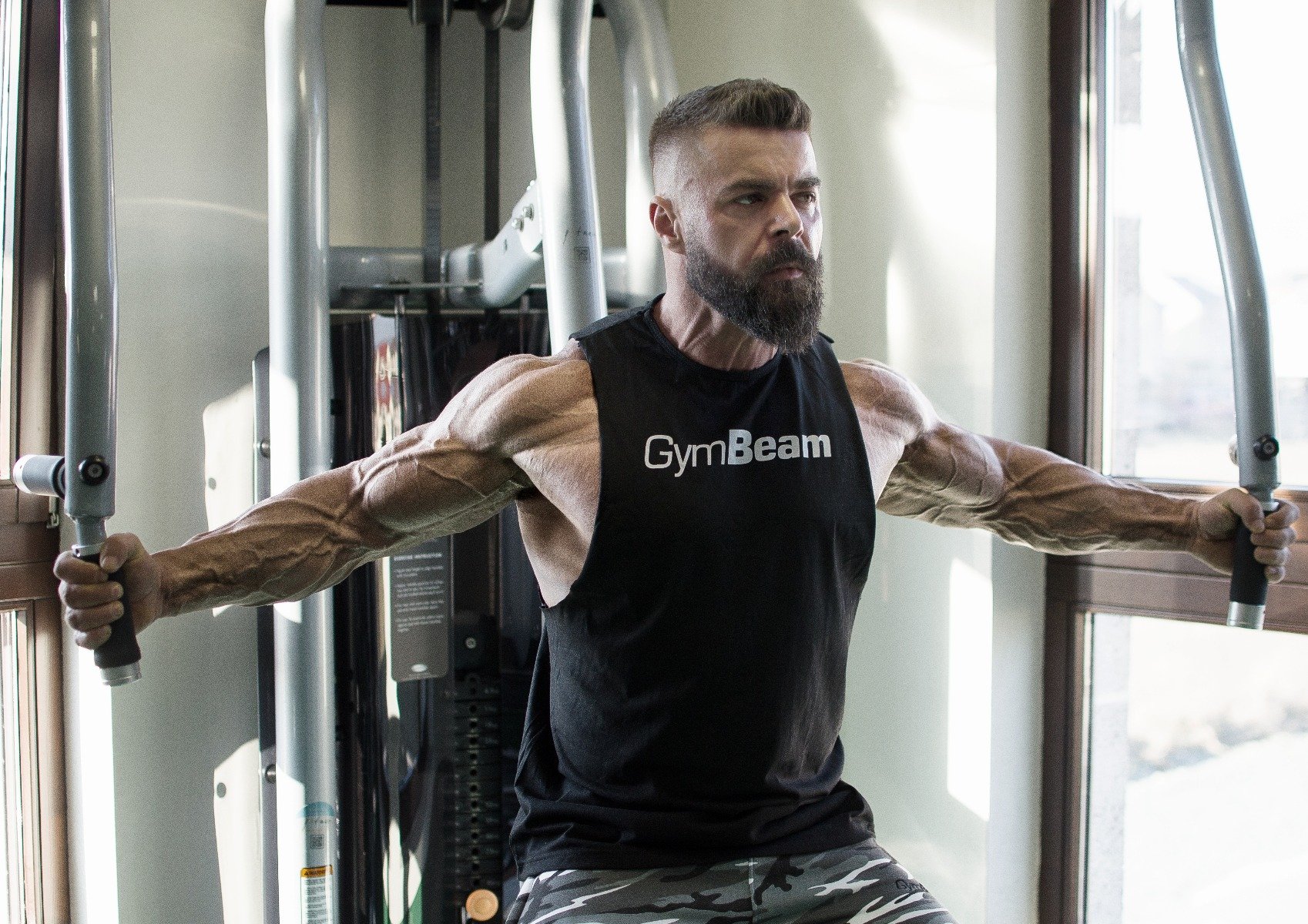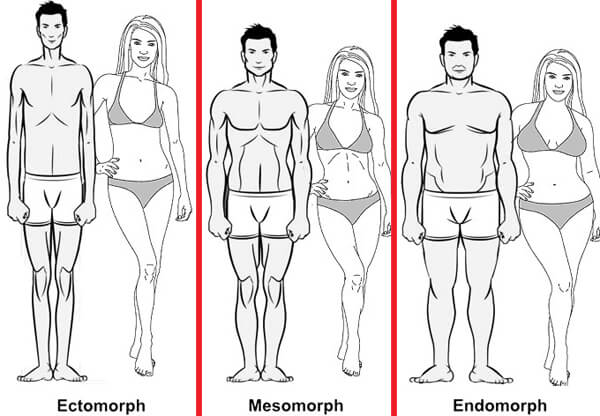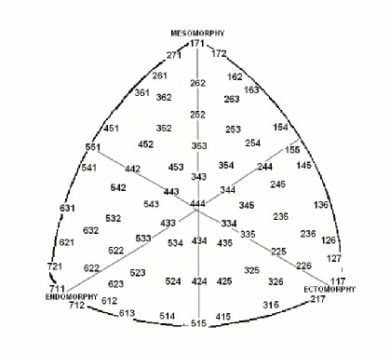Table of Contents
Have you started to exercise, you take it seriously, but the expected progress is not coming? Do you pay attention to the technique of doing exercises, do you have everything thought through, and your diet is honest? Then, what’s the problem? Is there insufficient progress caused by your genetics?
Our genetic information is organized in chromosomes. Human has 46 chromosomes, 23 from each parent. Imagine them as a book with thousands of information about our body. [17] Genetics determines the parameters of our body. However, we often cannot figure the famous and elaborated bodybuilders at the beginning of their careers. You might even think they were just born with muscles. However, no one is born as a “superhero”, right?
In 2009, a group of scientists sought to calculate the likelihood of existence of such a human being who would have all the genes beneficial for strength – all the prerequisites to become a born strongman. The result was very interesting. With a population of 6 billion people on our planet, only 2 people could have 17 out of these 22 beneficial genes. What does it mean? We are all born with some prerequisites to get our bodies in shape. After all, the “two lucky ones” of the study have only the potential for strength. It does not mean that they will develop it in life. [16]
Each of us has a body which differs from other ones in something. Muscle growth affects the type of striated muscle fibres, fat distribution, hormone levels, but also the quality and duration of our workouts. In this article, you will learn more about the factors that influence progress in your exercise. We cannot change the types of striated muscle tissue, hormone levels, or fat distribution. However, we can learn more about them and use our new information to improve our training. [1]

How does the brain communicate with our muscles?
Muscle tissue is organized into a group with a motor unit. The motor unit is simply a bundle of muscle fibres. The reason why muscle tissue is organized this way is simple – communication. What happens in your body when, for example, you want to raise your hand? Your brain sends a signal through the spine that gets into the motor unit. [5]
What types of striated muscle tissue do we know?
Let’s focus on the striated muscles that we can control and thanks to them, we can do sports. You may not have known that this tissue can be classified into several types.
There are three types of striated muscle tissue [2]:
1.Type I – slow oxidative (slow-twitch)
2. Type II – fast oxidative (fast-twitch)
1. Type IIA
2. Type IIB
Type I – “red” tissue – has a higher density and number of capillaries. It is rich in myoglobin and mitochondria, which is why it is red in colour. Muscle contraction occurs more slowly, even without much effort. Type I handles aerobic activity well because it uses fats and carbohydrates as its energy source. [3]
Type II – (fast-oxidizing) tissue – less myoglobin and mitochondria are found in this tissue. Muscle contraction is rapid and with a large dose of strength. The tissue is strong but is not able to last long. This type of tissue ensures our strength and when exercising with weights, muscles with such tissue grow. Type II has two subtypes – IIA and IIB. [3]

The brain knows how much and which tissue it needs for a certain activity. Based on this, it sends signals to specific motor units. Waving your hand requires engaging less muscles than holding a 10 kg bag on the way home from purchase. To exert greater force, the brain must send a signal to sufficient motor units of fast-oxidizing muscles (Type II). [3]
You might be interested in these products:
The tissue types I and II fundamentally differ from each other. The differences between sub-types IIA and IIB are not significant, but it is good to know them. The IIA and IIB subtypes can achieve the same peak performance in terms of value. However, the Type IIA needs more time to do this. The difference is shown in this table [5]:
| Type I | slow | 100 milliseconds | slow |
| Type IIA | quick | 50 milliseconds | quick |
| Type IIB | very fast | 25 milliseconds | quick |
A more detailed difference between IA, IIA and IIB tissue types is given in the following table [4]:
| Contraction rate | slow | quick | very fast |
| Size of motor neurons | Low | great | very big |
| Fatigue resistance | High | medium | Low |
| Determination by activity | aerobic | anaerobic (long lasting) | anaerobic (short lasting) |
| Production of power | Low | High | very high |
| Mitochondrial density | High | High | Low |
| Capillary density | High | medium | Low |
| Oxidation capacity | High | High | Low |
| Glycolytic capacity | Low | High | High |
| Type of fuel | triglycerides | creatine phosphate, glycogen | creatine phosphate, glycogen |
How does genetics affect this process?
Muscles in our body are a combination of muscle types I and II. The type I and type II ratio is genetically determined. [1]
What does it mean? Imagine you are practicing your triceps. After a while, you see the result, but your friend has achieved the same result in less time. It does not mean that he practiced more or technically better. His triple shoulder arm has a higher ratio of type II tissues.
What type of physique were you born with?
The physique type is a very common reason why people refuse to exercise. “I don’t have a physique suitable for exercising. I could be at the fitness centre every day, and I wouldn’t gain any muscles after months of sheer drudgery.” Do you think these are evasive words? It doesn’t have to be true.
Do we get the physique genetically? Are there specific types physiques? Yes and yes.
Already in ancient Greece, people thought about the possibility that there are several types of human body. Plato dealt with this issue. In the 19th century, Frederick Nietzsche also pursued this idea. However, it was precisely determined by American psychologist William Sheldon. He defined three somatotypes of a human physique [6]:
- Ectomorph
- Mesomorph
- Endomorph
Are you wondering which group you belong to? Try it first as shown in the figure. [7]

1. Ectomorph – looks skinny, has long limbs. Its rapid metabolism can convert sugars into energy very quickly. This, of course, results in ectomorph having a problem of gaining muscle mass. It does not have muscle type II (rapidly oxidizing) developed sufficiently. However, this does not mean that it cannot increase strength. Can ectomorph gain muscle mass? It’s not impossible. To increase body weight, however, it has to eat much more than other body types. Even after successful weight gain, their calves and forearms may still look poor. [6][8]
2. Mesomorph – does not look skinny, but neither rounded. It has wide shoulders, narrow waist, small joints. The physique is located between the ectomorph and the endomorph. Its physique is “naturally athletic” or muscular, even without a daily fitness visit. However, this does not mean that mesomorph does not need to exercise and can eat anything. It is true that this type of physique can get back into shape more quickly. It is capable to gain weight easier and also faster lose excess fat. [6][8]
3. Endomorph – shorter limbs, broad hips and rib cage. The largest of somatotypes. They gain body weight quickly, but with a lot of fat. Their body stores energy in the muscles and fats in the lower body. It is very difficult for them to keep their fitness and weight in norm. Like previous somatotypes, the endomorph can be fit. It can excel in higher strength because of easy weight gain. However, if it stops keeping in shape, the road to fitness will be very difficult. [6][8]
How do I find out which type of physique fits on me?
One of the most used ways to find out is the Heath-Carter method. Using this method, it is possible to determine the somatotype of your physique. It measures the shape and composition of your body. The result is a three-digit number, each number designating endomorphic, mesomorphic and ectomorphic elements. The element values range from 1 (low) to 7 (high). A value sheet is used for getting results. From the finite number, we can then determine if our physique is more endomorphic (e.g. 6-2-2), mesomorphic (e.g. 3-5-2), or ectomorphic (e.g. 3-3-5). The result can also be used to determine which sport your physique is more suitable for. [18]
For a better idea, we present a Heath-Carter graph with values [19]:

What causes someone to be born as an ectomorph and other as an endomorph?
The most important genetically congenital traits that influence the physique’s somatotype are [9]:
- Physical features – height, length, width, muscle mass, fatty tissue
- Personality traits – emotionality, sociability
- Sexual orientation
- Mental disorders
Fat distribution and genetics
“I gain weight even if I drink a glass of water.” The notorious sentence, which of course is a myth. Each of us takes fat into different parts and in different amounts. Do you think a person can have total control of fat distribution? This is not entirely true.
Fat distribution in our body is influenced by four basic factors [10]:
- Genes – According to a 2017 study, nearly 50% of the fat distribution in our body is influenced by genetics.
- Gender – women gain weight in other parts of the body (hips and buttocks) than men (abdomen). In addition, the female body contains 14 to 31% fat, while the male body contains 6 to 24%
- Age – slower metabolism and loss of muscle mass results in older people having more fat in their bodies.
- Hormones – hormone levels and weight interact, especially after the age of 40. This is due to the natural loss of estrogen and testosterone.

Is the amount of fat also recorded in our DNA?
The fact that the amount of fat in our body affects our DNA confirms the 2007 discovery. It is the result of research conducted on children and adults in the UK and Europe. As a result, some variation of the FTO gene was associated with excessive body fat, obesity, and type 2 diabetes. [11]
However, this discovery cannot be taken as an “overweight judgment” Just because you have this variant of the FTO gene does not mean you will surely suffer from obesity. This variant rather causes a susceptibility to obesity. Research carried out on schoolchildren in Scotland shows a link between higher-weight children and the FTO variant of the gene. Tests showed that the FTO variant did not cause slow metabolism. The problem was the amount of high-calorie food. [12]
If you are not careful about your diet and sufficient movement, the FTO gene will be responsible for your weight gain. But there is no need to worry about excessive weight gain in a balanced diet and sport activity.

The fats vary
It should not be forgotten that fat is beneficial in our body. It depends on the amount of fat and its type. Our body contains three types of fat [10]:
- Subcutaneous – located directly under the skin and on the muscle surface. It accounts for 90% of our fat repository. We can change its amount.
- Visceral – fat that envelops our organs, such as the liver. It cannot be felt or caught. However, its lack or surplus may cause health problems.
- Brown – the type of fat that maintains our body temperature. It occurs in the area of the shoulders and back.
What about hormones and genetics?
Hormones are very important for muscle growth. Some directly and some only indirectly. Testosterone, growth hormone and insulin-like growth hormone are responsible for muscle strength and growth. Cortisol, adrenaline, norepinephrine and glucagon are responsible for fuel supply (glucose). [13]
The level of testosterone in a man’s body changes in the course of life. In addition, two men of the same age may not have exactly the same testosterone level.
However, in 2011, researchers found that low testosterone levels may be caused by genetic predisposition. The genetic variants of SHBG (sex hormone-binding globulin) and the 10th chromosome are associated with low testosterone levels. Its low levels can cause cardiovascular disease, type 2 diabetes and others. However, why every man does not have the same testosterone level is a mystery to scientists so far. [14]
No less important hormone for muscle growth is growth hormone. However, it also affects the growth of the child. Its deficit is rather unusual, affecting 1 in 5,000 people. [15] The fact that you will probably gain fat more easily in old age must not be a reason for resignation. The more we know about our body, metabolism, or genes, the better we can direct our organism towards a healthy path.
All the combinations of information in our DNA make us original. Most important of all, however, is potential. Knowing your somatotype is very helpful because it affects our training and diet plan. Still, whatever the proportion of cross-striated tissue types, motivation is more important. Genetics seems relentless, but the result is up to you. Remember, our body needs fat but only the right amount. The rest is about renunciation, hard work and self-control.
Are you more satisfied after reading this article? We are born with a certain gene pool, but one can always work way up. Whether you have an ectomorphic, endomorphic, or mesomorphic physique, we believe this article has been helpful to you. Do you want your friends to know about this article too? Feel free to support it by sharing.
[1] Mandy Ross – Genetic Impact on Building Muscle – – https://www.livestrong.com/article/332806-is-the-ability-to-build-muscle-genetic/
[2] Jason R. Karp – Muscle Fiber Types and Training –– https://pdfs.semanticscholar.org/73f1/6eccedb6eea54d74ab7de9d2c14ee0c9d7c2.pdf
[3] Christian Nordqvist – Muscles: Why are they important? – – https://www.medicalnewstoday.com/articles/249192.php
[4] Judith R. Karp – Muscle Fiber Types and Training Types of Muscle Fibers – – https://www.semanticscholar.org/paper/Muscle-Fiber-Types-and-Training-Types-of-Muscle-Karp/075aa790d6b73041ee7922e8bd817c8cb3d3071d
[5] Kelly Baggett – Understanding Muscle Fiber Types – – https://www.bodybuilding.com/fun/kelly13.htm
[6] Joel Snape – Ectomorph, Endomorph And Mesomorph: How To Train For Your Body Type –– https://www.coachmag.co.uk/lifestyle/4511/ectomorph-endomorph-or-mesomorph-what-is-your-body-type
[7] Michael Matthews – The Best Diets and Workouts for Your Body Type – – https://legionathletics.com/body-types/
[8] Ben Creicos – What Is Your Body Type? Take Our Test! – – https://www.bodybuilding.com/fun/becker3.htm
[9] Florescu Oroles – THE DETERMINING FACTORS IN THE FORMATION OF THE THREE BODY TYPES (ECTOMORPH, MESOMORPH AND ENDOMORPH) –– https://pdfs.semanticscholar.org/2a1d/cbb2c71cbacb9c23ec95e6e36a0afba58f6e.pdf
[10] Marygrace Taylor – Everything Body Fat Distribution Tells You About You – – https://www.healthline.com/health/fat-distribution#1
[11] Miranda Hitti – Obesity in the Genes? – – https://www.webmd.com/diet/news/20070412/obesity-in-the-genes#1
[12] Miranda Hitti – How the FTO Obesity Gene Works – – https://www.webmd.com/diet/news/20081210/how-the-fto-obesity-gene-works
[13] Paul Rogers – How to Stimulate Hormones for Bodybuilding – – https://www.verywellfit.com/build-muscle-by-manipulating-hormones-3498515
[14] Petra Rattue – Male Testosterone Levels Influenced By Genetic Makeup – – https://www.medicalnewstoday.com/articles/235724.php
[15] Mike Addelman – Gene test for growth hormone deficiency developed – – https://medicalxpress.com/news/2018-04-gene-growth-hormone-deficiency.html
[16] Bret Contreras – The Odds Of Being Born A Superhero: An Examination Of The Genetic Limits To Strength – https://bretcontreras.com/odds-born-superhero-examination-genetic-limits-strength/]
[17] Ananya Mandal – What is Genetics? – – https://www.news-medical.net/life-sciences/What-is-Genetics.aspx
[18] J.E.L. Carter – THE HEATH-CARTER ANTHROPOMETRIC SOMATOTYPE – INSTRUCTION MANUAL – – https://www.mdthinducollege.org/ebooks/statistics/Heath-CarterManual.pdf
[19] Zuzana Štěrbová – Father’s physique influences mate preferences but not the actual choice of male somatotype in heterosexual women and homosexual men – – https://www.researchgate.net/publication/320129865_Father's_physique_influences_mate_preferences_but_not_the_actual_choice_of_male_somatotype_in_heterosexual_women_and_homosexual_men


Add a comment